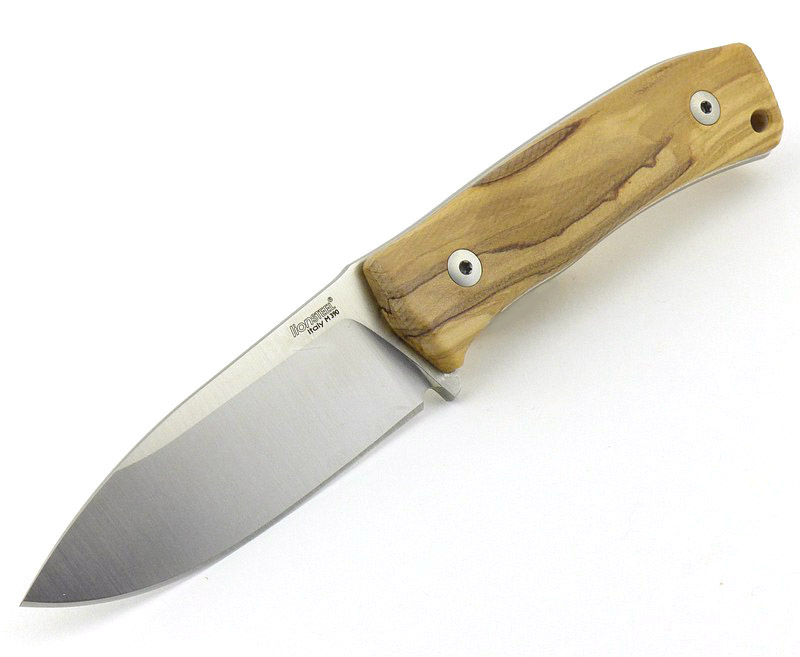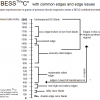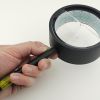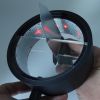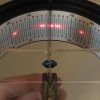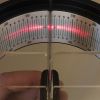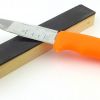If the Lionsteel M4 is not on your list of candidates for a utility / bushcraft / general purpose fixed blade knife, it should be. It is not a new model at the time of this review, now entering its third year of production, and the Mik Molletta designed M4 from Lionsteel seemingly finds that perfect – just right – size, weight and balance. Once you pick a M4 up, it feels like it was made for you, and simply belongs in your hand.
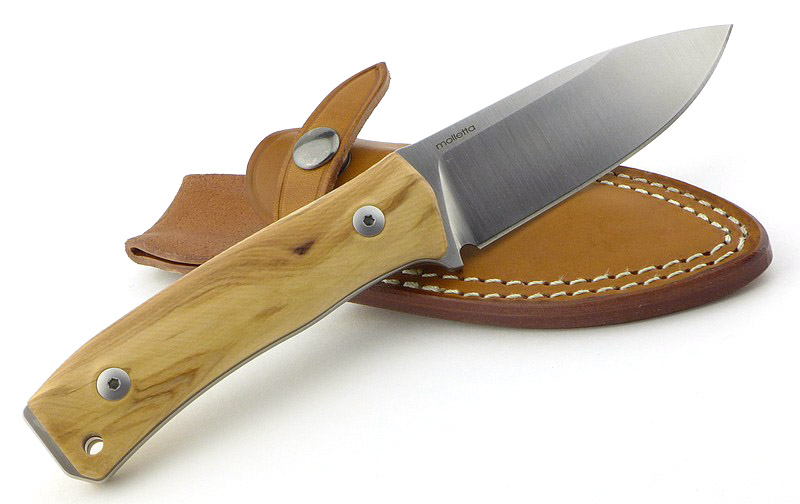
A few more details:
The M4 featured in this review is the Olive wood handled version. Given a choice, I thought what better handle material for a knife that is Italian designed and made (and grown).
What’s in the box?:
A good look round the M4 – Things to look out for here are:
Starting with the sheath, it is clear as you look through the photos how well made this sheath is.
Then the M4 itself. Lionsteel’s premium quality of manufacture shines through in every detail. The faithful reproduction of Mik Molletta’s design, including the sculpted handle, makes this a pleasure to handle and use.
Explained by the Maker:
The reasons for certain design choices may not be clear when simply looking at an object, so this section is intended to give an insight into the thinking behind a design by speaking to the designer themselves.
Mik Molletta has generously given his time to explain design choices, and give some background to the M4. The descriptions in this section come from our discussion.
The M4 was actually designed some time ago and because the project was so satisfying, Mik decided to propose it to Lionsteel.
Intended as a little multipurpose knife, the size and shape of the blade (A) allows excellent versatility in all aspects of outdoor life. The finger guard (B) has been sized in order to stop it being cumbersome but still protect the hand, and it also provides an easy reference for the index finger.
A spear point (C) was chosen as it is versatile and robust, and allows you to do hard work. For its size the M4 has quite a thick blade, this thickness (D) was chosen because the knife is still a tool that can be called upon to perform even heavy work like batoning.
M390 (D) is one of few stainless steels that with specific heat treating can have secondary hardening. It is Mik’s opinion that tempering this steel in the ordinary way, as most of the cutlery does, does not fully exploit the potential of this steel.
The flat grind (E) is ‘high’ but not ‘full’. Having a full thickness part of the blade reinforces it and makes it suitable for heavier work.
Mik’s designs tend to include a sharpening choil (F). This is because during the subsequent sharpening, if there were not the choil, that part of the edge would be rounded up because it would not be able to contact the stones properly. This would result in having a long piece of edge that cannot be sharpened which ends up growing over time.
The handle is bolted (G) on instead of riveted. In Mik’s opinion, bolts are a better fastener for more durable tools. Rivets can yield or loosen and cannot be tightened.
Handle shaping (H) is a careful process of sculpting the form while looking at the fit into Mik’s own hand.
When it came to the sheath design (I), this was collaboration between Mik and Gianni. The double stitching (J) guarantees greater durability at the cost of a small increase in size.
For left-handed users (K), Mik and Lionsteel are thinking of making some specific sheath or modular sheath like the one on M7, that can also be used by left-handed users.
The butt of the knife has an exposed tang (M), and can be used to strike or press.
When asked about the palm swell (N) Mik commented – during use of the knife, the hand tends to move on the handle to look for the most comfortable grip. It happens naturally. A pronounced palm swell limits this possibility. On the big knives, like the M7, the bigger palm swell helps to hold the knife firmly.
The Blade and Handle – Detailed Measurements:
Now even more detailed!
Taking things far beyond most knife specifications, in this section I will be carrying out a detailed examination of geometry, balance, edge bevels, factory sharpness and structural edge testing using the industry leading measuring tools.
These measuring tools include a Vernier protractor, callipers, fixed radius gauges, the unique Arc Master adjustable radius gauge, Edge On Up’s BESS Certified PT50A and SET tester along with CATRA’s Hobbigoni LASER Edge Protractor.
The BESS ‘C’ scale of sharpness (Brubacher Edge Sharpness Scale) will be used to verify the sharpness of the factory edge and allow the knife to be brought to a minimum standard sharpness before testing a blade’s cutting performance.


The measurements have been tabulated and are presented along with a few reference blades. The ‘Balance relative to the front of the handle’ tells you if the knife will feel front heavy, or if the weight is in your hand (a positive value means the weight is forward of the front of the handle). The ‘Balance relative to the centre of the handle’ indicates how close to a ‘neutral balance’ the knife has in the hand.

The blade is made from M390 steel.
What it is like to use?
Big knives; who doesn’t love them?! But the reality is that most of your normal ‘utility’ tasks are far better served with a smaller, lighter and more agile knife.
I have a confession – I very nearly passed over this knife. It doesn’t shout for attention amongst many other fine blades, and your every-day working knife is easily overshadowed by the glamorous show knives. Please don’t make the same mistake – it has been one of those small revelations as to how good this knife is.
Reflecting a little more on why I nearly overlooked this, I think it may stem from the general attitude the UK has towards knives and knife carry. If you have ‘good reason’ to carry something more than a SAK, the appeal is to take that big camp knife out rather than the more useful and sensible sized utility knife.
Before you even get onto using the M4, it really shows its quality of manufacture which marks it out as something special.
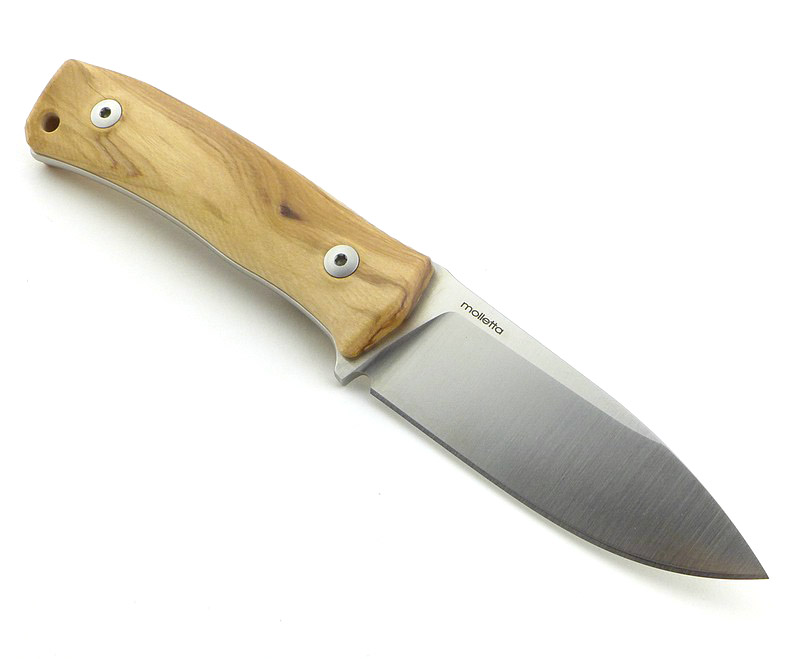
For reference I wear XL sized gloves, so even with reasonably large hands this knife doesn’t feel too small. It is very comfortable and nimble in the hand. The blade length lends itself to those controlled power cuts without any excess blade waving around. You only make a power cut with the first inch or two of blade next to the handle anyway. With only a sharpening choil (instead of a finger choil) you have that optimum power with all fingers on the wooden handle.
If the blade had a slightly thinner blade, it would make slicing cuts through thicker materials easier and the knife a bit lighter. However Mik Molletta’s designs tend to err on the side of strength, and so the blade stock used is just that bit thicker than many knives this size. This adds a reassuring solidity to the design without really impacting on its cutting ability. I can only really see an issue if cutting a lot of thick cardboard or similar stiff sheet material – not really a concern here as the M4 is described as a ‘bushcraft’ knife.
In its role as a bushcraft knife, the thickness of the blade means that you won’t have any worries batoning with it, and also being a full tang knife, it is just not going to let you down by breaking. Also importantly here, the comfort of the handle means you can carry out a lot of wood preparation without it causing fatiguing or creating hot-spots. Just going back to the blade thickness again, combined with the rounded spine, it is very comfortable to place your thumb on the spine for extra pressure or control.
As you will see in the summary section, I’ve been struggling to find things I don’t like about the M4. There are a couple of minor negatives. The first does not affect me, but is just to say that the sheath is right-handed only. The second has not yet fully become a problem, and might not, but I have found that when inserting the M4 into the sheath the blade tip has caught on the internal stitching of the belt loop. My worry is that if the threads get cut through they might unravel, and the belt loop then fail. I’ve started to be very careful and deliberate when sheathing the M4 to avoid this – not something I really want to think about.
The M4 is a superbly practical knife and in so many ways it is ‘just right’. Small and light enough for all-day carry without being weighed down. Large enough to be put to serious work. High performance steel without being impossible to sharpen. Strong enough to take everything in its stride. Manufacturing quality to make you smile without being ‘too good to use’.
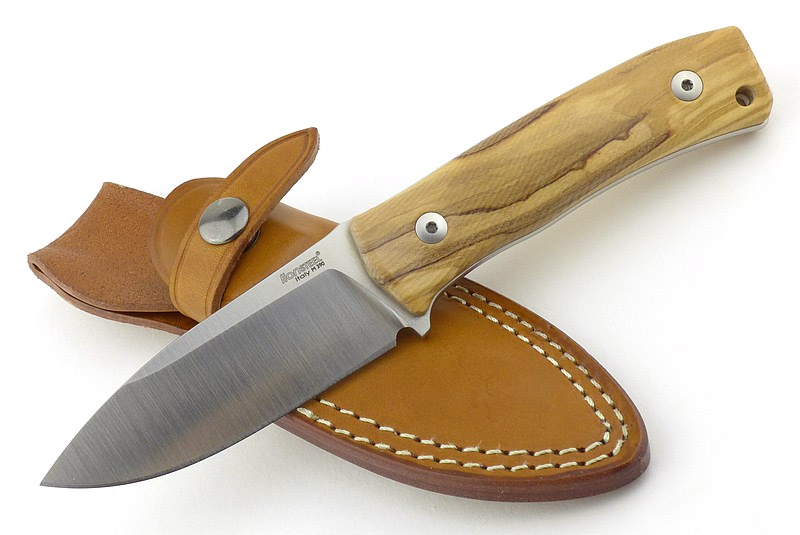
Review Summary
The views expressed in this summary table are from the point of view of the reviewer’s personal use. I am not a member of the armed forces and cannot comment on its use beyond a cutting tool or field/hunting knife.
Something that might be a ‘pro’ for one user can be a ‘con’ for another, so the comments are categorised based on my requirements. You should consider all points and if they could be beneficial to you.
_______________________________________________
Things I like
_______________________________________________
Super practical size.
Extremely well made.
Strong blade / full tang.
High performance steel.
Quality leather sheath.
Comfortable grip even for extended periods.
Beautiful Olive wood handle.
_______________________________________________
What doesn’t work so well for me
_______________________________________________
Sheath is only right handed.
Blade tip catches internal belt loop stitching when sheathed.

Discussing the Review:
The ideal place to discuss this reviews is on a forum. If you started reading the shorter forum version of the review, but followed the link this full exclusive review, please return to that forum to discuss the review there.
If you read the review entirely on Tactical Reviews, please consider one of the following to join in any discussion or start a new one.
BladeForums – Knife Reviews (US based Forum for Knife Discussion)
CandlePowerForums – Knife Reviews Section (Largest and Friendliest Flashlight Community Forum)
The BESS Exchange – A forum discussing technical aspects of sharpness and truly understanding your sharpening process.


